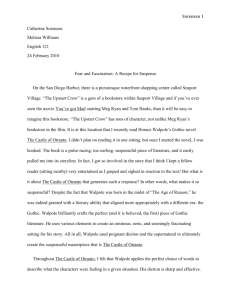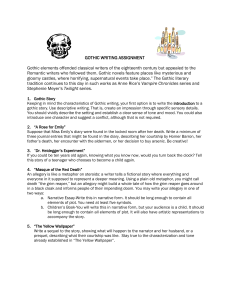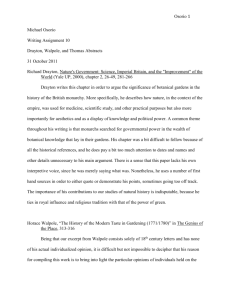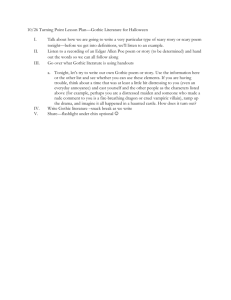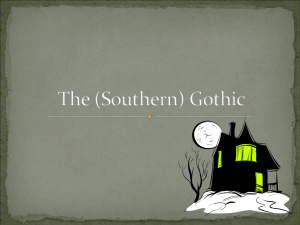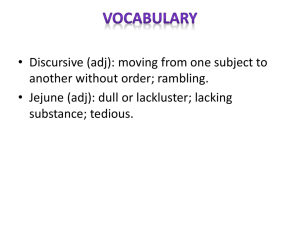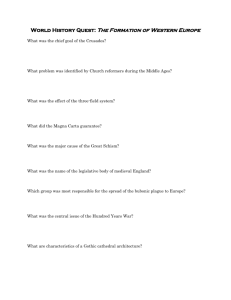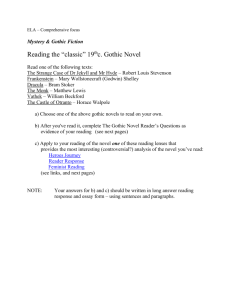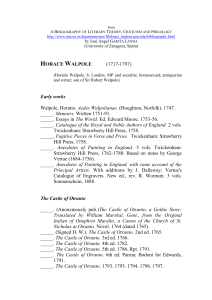Horace Walpole and The Gothic
advertisement
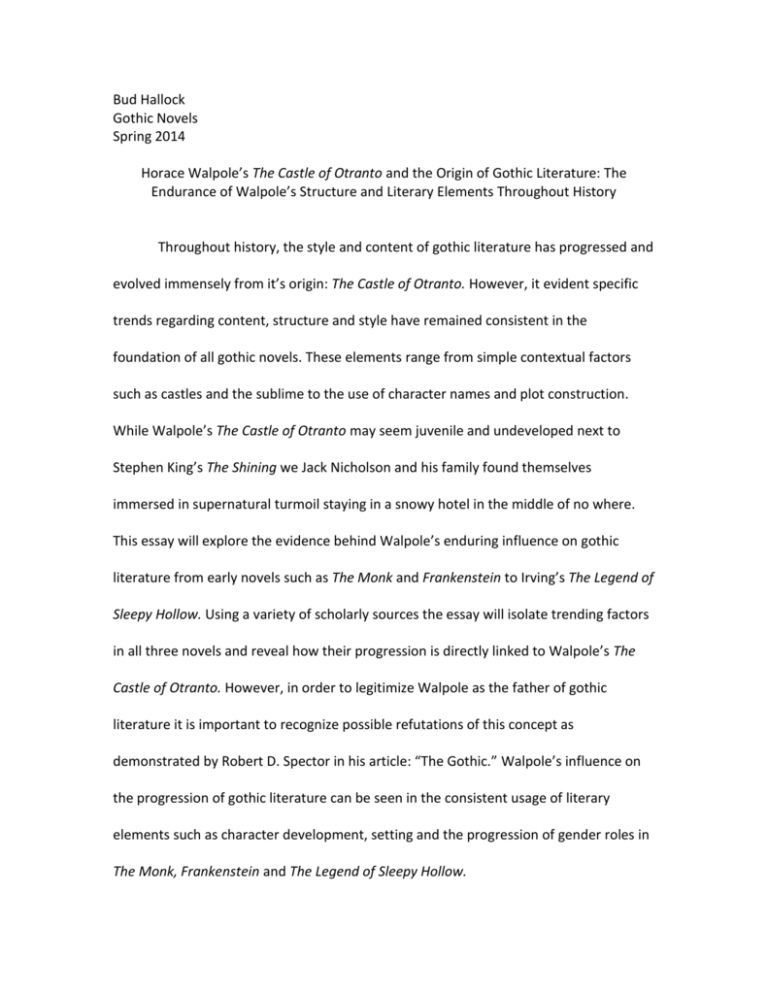
Bud Hallock Gothic Novels Spring 2014 Horace Walpole’s The Castle of Otranto and the Origin of Gothic Literature: The Endurance of Walpole’s Structure and Literary Elements Throughout History Throughout history, the style and content of gothic literature has progressed and evolved immensely from it’s origin: The Castle of Otranto. However, it evident specific trends regarding content, structure and style have remained consistent in the foundation of all gothic novels. These elements range from simple contextual factors such as castles and the sublime to the use of character names and plot construction. While Walpole’s The Castle of Otranto may seem juvenile and undeveloped next to Stephen King’s The Shining we Jack Nicholson and his family found themselves immersed in supernatural turmoil staying in a snowy hotel in the middle of no where. This essay will explore the evidence behind Walpole’s enduring influence on gothic literature from early novels such as The Monk and Frankenstein to Irving’s The Legend of Sleepy Hollow. Using a variety of scholarly sources the essay will isolate trending factors in all three novels and reveal how their progression is directly linked to Walpole’s The Castle of Otranto. However, in order to legitimize Walpole as the father of gothic literature it is important to recognize possible refutations of this concept as demonstrated by Robert D. Spector in his article: “The Gothic.” Walpole’s influence on the progression of gothic literature can be seen in the consistent usage of literary elements such as character development, setting and the progression of gender roles in The Monk, Frankenstein and The Legend of Sleepy Hollow. Mathew Gregory Lewis’s The Monk explicitly shows Walpole’s influence regarding character development and the locale for supernatural occurrences. First and foremost, the nature of terror and horror in The Castle of Otranto is seemingly juvenile in comparison to The Monk. While Walpole uses a giant knight, Lewis uses what has become the peak of terror in the gothic: the devil. However, while The Monk is implicitly “scarier” Lewis uses the locale of a castle almost consecutively after Walpole. However, what separates The Monk and The Castle of Otranto is the simple progression of the female role in horror and terror: The damsel in distress is a chief character in gothic literature, where she is typically incarcerated in a castle or monastery and terrorized by a sadistic nobleman, or members of the religious order (R, Jamie 1). Matilda a bystander to her father’s aggression resembles the helplessness that Walpole uses to construct the female role: “She was surprised at not seeing Isabella; but the strange words which had fallen from her father, and his obscure menace to the princess his wife, accompanied by the most furious behavior, had filled her gentle mind with terror and alarm (Walpole, 39). However, within the confines of a supernatural castle the role of women is transformed in The Monk. While, the female in The Castle of Otranto puts forth a gender role regarding vulnerability to the wicked man as seen by Manfred’s aggressive pursuit of Isabella; The Monk transforms the gender role with Matilda’s character who deviously pursues the male, turning out to be entirely evil and satanic. While the gender role may be changing here there are further implications as seen by Yatsugi’s analysis of Matilda’s character development. Yatsugi implies that after the seduction of Ambrosio her character becomes more masculine as her demonic influences develop: “Matilda is sexually divided…. After she seduces the monk, she oddly becomes more and more masculine instead of more feminine” (Paglia, 4). Although we see the aggressive virtue of a lustful woman, Matilda in a further analysis we come to realize that the role of women as vulnerable remains intact. Matilda in fact is subdued by Lucifer which is revealed at the end of the novel. Although Matilda seduces Ambrosio making him the vulnerable one, the entire occurrence is supported and dictated by an aggressive male figure: the devil. While the role of female interaction may have been flipped in the Monk we see the vulnerability of females in both Frankenstein and The Legend of Sleepy Hollow. Although Lewis deliberately changes the course for the development of the female in the gothic novel, it is only a small modification that inevitably holds true to Walpole’s structural use of vulnerability regarding females. Mary Shelley cultivates human potential and immoral ignorance as the source of evil in her novel Frankenstein. Frankenstein is undoubtedly one of the most prestigious gothic novels and although in this case the supernatural is a product of scientific achievement, Shelley continues to maintain the theme of vulnerable women at the hands of evil. Although Isabella is subject to an assertive and deliberate evil man; in Frankenstein Victor’s wife, Elizabeth is subject to the evil which derived from Victor’s neglect for his creation. This notion creates the idea that one man’s failure to uphold moral behavior and take responsibility eventually results in hardship and death for those who surround him. This concept represents a certain helplessness that women endure in the gothic novel where they have no control over what is happening around them. Although Victor is not directly attacking Elizabeth he is the ultimate cause of her death as a result of his neglect for the monster. Walpole’s influence is ore explicitly found in the development of supernatural and evil characters as seen in Washington Irving’s The Legend of Sleepy Hollow. In The Castle of Otranto Walpole uses a massive knight as the supernatural figure. The structure surrounding the concept of a supernatural knight or soldier resembles that of a higher power. More specifically, war figures resemble the peak of male involvement and dedication to society. Whether this dedication is inherently evil or morally fulfilling their influence on history and society is constant. Washington Irving uses a headless horsemen as the subject of supernatural evil making Walpole’s influence on character development more than just explicit but immortal. The involvement of the giant knight in Otranto resembles an esteemed, powerful member of society coming back from the dead and immersing ones self in the affairs of the living. Walpole’s influence regarding female gender roles in gothic literature can vary from one situation to the next however, he directly influenced the development of supernatural evil characters as well. While Horace Walpole is considered the pioneer in gothic literature it is important to understand the further implications regarding Walpole’s influential figures and furthermore the context of history in regard to literature development. “Not even the most myopic scholar ever believed that the gothic novel came naked into the world in 1764, prancing forth fully grown from Horace Walpole’s imagination and unattended by handmaidens from the muses of the sister arts” (Spector, 1044). As seen by Mary Shelley’s Frankenstein, romantic ideals are deeply imbedded in gothic literature. For instance, the sublime and exotic natural locations applies to almost every gothic text. In Frankenstein we see Victor venture to a frozen tundra. Furthermore, Shelley plays with the concept of human possibility where man overcomes religious and societally boundaries by creating artificial life. The structure of Frankenstein is a direct result of imagination and creativity which Walpole exerts through a novel written in two months: “From a broader view the emergence of Walpole’s gothic novel may be seen as a part of widespread general interest in a relaxation of artistic restraints and an increased desire for imaginative freedom” (Spector, 1044). Therefore, the consistent application of Walpole’s original structure, style and literary elements relies on the rejuvenation of imaginative, romantic minds such as Mary Shelley. Similarly, the emergence of gothic literature is partially credited to the historical implications of the time in which Walpole wrote The Castle of Otranto: “Starting early in the eighteenth century, an expanding interest in the emotional experiences associated with the sublime was apparent, whether in Joseph Addison’s attempt to account for his response to the awesome character of mountains or Alexander Pope’s fascination with mysteries of a grotto” (Spector, 1044). While Walpole may have taken the first initiative to engage with a new form of literature he was directly influenced by the progression of literature during his time. Surrounded by the adolescent stages of romantic thinking Horace Walpole generated the origin of gothic literature through the construction of The Castle of Otranto. Through a combination of imaginative thinking and an interest in horror and terror The Castle of Otranto is noted as the first true, gothic novel. While the literary elements and themes of gothic novels may vary and evolve over the course of time there are particular standards that have endured through the progression of the gothic over time. Mary Shelley and Washington Irving published there novels at different time periods during different literary movements. However, certain themes regarding gender roles, supernatural characters and the depiction of settings can all be traced back to The Castle of Otranto. The Supernatural Subject: Otranto to Hollow 1764 1820 Works Cited Bruhm, Steven. "The Contemporary Gothic: Why we Need it." The Cambridge Companion to Gothic Fiction. Ed. Jerrold E. Hogle. Cambridge: Cambridge University Press, 2002. 259-276. Print. Williams, Anne. "Horace in Italy: Discovering a Gothic Imagination." Gothic Studies 8.1 (2006): 22-34. Print. Yatsugi, Aya. “The Double in Gothic Romance: A Study of The Monk, Frankenstein, “William Wilson,” The Stange Case of Dr Jekyll and Mr Hyde, and The Picture of Dorian Gray.” http://www.ube-k.ac.jp/~yatsugi/r-yatsugi.pdf Yahoo Contributor Network. “Centrality and Vulnerability of the Female Form in Gothic Literature.” http://voices.yahoo.com/centrality-vulnerability-female-formin-6684740.html (2010) Spector, Robert D. “The Gothic.” Copyright of Encyclopedia of Literature and Criticism, Routledge. http://web.b.ebscohost.com/lrc/pdfviewer/pdfviewer?sid=240453bb-7a8a-41ab8f83-2c63a122ec68%40sessionmgr110&vid=8&hid=121 Walpole, Horace. “The Castle of Otranto.” Oxford University Press. (1764). Lewis, Mathew G. “The Monk.”


